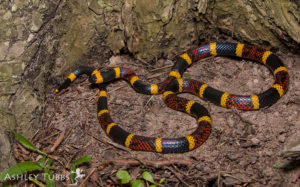The United States is home to three species of venomous coralsnake in two genera. The Harlequin (Eastern) Coralsnake and the Texas Coralsnake are in the genus Micrurus, while the Arizona Coralsnake is placed in the genus Micruroides.
All three species are venomous Elapids (Family Elapidae) and possess neurotoxic venom, which works to paralyze the nervous system of their prey. These snakes have fixed front fangs, not rear fangs, which is a common misconception.

In general, coralsnakes are shy, retreating animals, which spend a lot of time buried in leaf litter, loose soil, sand, and under objects such as rocks, logs, and within root systems. Heavy rain and the urge to find a mate will bring coralsnakes to the surface. They will also emerge to follow a scent trail or after being disturbed by human activity.
Coralsnakes feed exclusively on other reptiles, including other snakes. Female coralsnakes lay eggs and the young are born equipped with venom just as potent as adults, ready to hunt down their first meal.
Coralsnakes are the subject of many myths and misconceptions. Please refer to the article linked below for more information. http://thevenominterviews.com/2016/06/02/mythbusting-coral-snakes/
Micrurus fulvius (Linnaeus, 1766) – harlequin coralsnake (U.S. coastal plains of North Carolina to Louisiana)
Micrurus tener (Baird & Girard, 1853) – Texas coralsnake (Texas and Louisiana south to Morelos and Guanajuato
Micruroides euryxanthus (Kennicott, 1860) – Arizona coralsnake (lowland regions from Arizona to Sinaloa, Mexico)